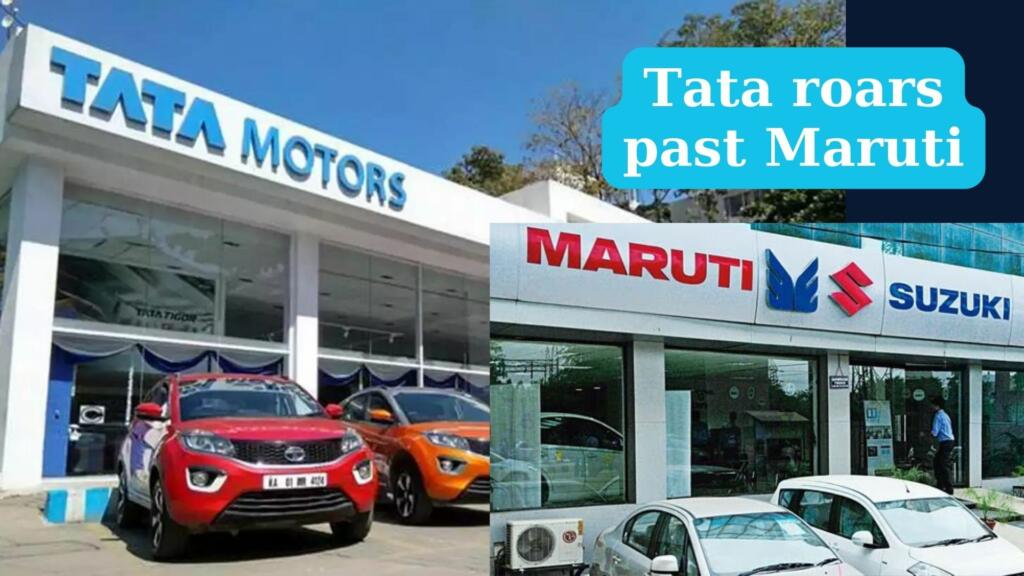Tata Motors and Maruti Suzuki stand as prominent figures in the Indian automotive industry, each with a unique history and trajectory. Maruti Suzuki, formerly Maruti Udyog Limited, emerged in 1981 as a joint venture between the Indian government and Suzuki Motor Corporation, enjoying a monopoly in the market till the early ’90s. In contrast, Tata Motors, a part of the Tata Group, initially focused on commercial vehicles before entering the passenger car segment in the late ’90s.
Maruti’s Monopoly
Maruti Suzuki, formerly known as Maruti Udyog Limited, is a subsidiary of the Japanese automaker Suzuki Motor Corporation. Established in 1981, Maruti Suzuki played a pioneering role in the Indian automotive sector. The company was formed as a joint venture between the Indian government and Suzuki, with the primary goal of creating affordable and fuel-efficient vehicles for the Indian market.
Maruti Suzuki’s journey in the Indian market began with the iconic Maruti 800, which was launched in 1983. This compact and economical car quickly became a symbol of middle-class aspirations and needs. The company enjoyed a virtual monopoly in the Indian automobile market till the early 1990s, primarily due to limited competition and the popularity of its small and affordable models.
Tata’s Steady Start
On the other hand, Tata Motors is a part of the larger Tata Group, a diversified Indian multinational conglomerate. Tata Motors initially entered the automotive industry with the production of commercial vehicles, starting in the 1950s. However, their presence in the passenger car segment was relatively limited in the early years.
Tata Motors’ significant foray into the passenger car market began in the late 1990s with the launch of the Tata Indica in 1998. The Indica was a landmark product for Tata Motors, being the first passenger car designed and produced entirely in India. The hatchback gained attention for its spacious interiors and fuel efficiency, marking a significant step for Tata Motors in the competitive passenger car market.
The Iconic Tata Indica
Despite initial challenges, the Tata Indica became an iconic car, symbolizing Tata Motors’ gradual expansion in the passenger car segment. This success paved the way for further innovations and product diversification.
In synopsis, while Maruti Suzuki enjoyed a monopoly in the Indian market in the early years, Tata Motors entered the passenger car segment with a sluggish approach, eventually making a mark with the iconic Tata Indica and expanding its presence in the Indian automotive industry.
Maruti’s Lack of Innovation and Safety Concerns
While Maruti Suzuki has been a dominant force in the Indian automobile market, there have been criticisms about its perceived lack of innovation in terms of product offerings. Some critics argue that Maruti has relied heavily on its established models and has been slower in introducing cutting-edge technologies or unique designs compared to global trends. Additionally, there have been concerns about Maruti’s approach to passenger safety in some of its earlier models. The company faced criticism for not prioritizing safety features as much as some of its competitors, especially in entry-level vehicles.
Tata’s Commitment to Innovation
In contrast, Tata Motors has been recognized for its commitment to innovation, particularly in the design and technology aspects of its vehicles. The company has invested heavily in research and development, aiming to bring advanced features and safety technologies to its products. This focus on innovation has been evident in Tata Motors’ recent models, such as the Harrier (SUV) and Nexon (Electric Vehicle), which have garnered attention for their modern designs and technological advancements.
Also Read: Who owns what? Your Car Brand may be owned by an automobile company you consider
Game-Changer Cars: Tata Harrier and Nexon EV
The Tata Harrier, introduced in 2019, has proven to be a game-changer in the SUV segment, with its striking design, robust features, and competitive pricing. Tata Motors has also been a pioneer in the electric vehicle (EV) segment, with the Tata Nexon EV providing a sustainable and eco-friendly alternative.
Maruti’s Swift Overreliance and Tough Competition
There has been criticism of Maruti Suzuki’s overreliance on certain successful models, notably the Swift series. While Swift has been a consistent best-seller for the company, there are concerns about potential stagnation in its product lineup and the need for refreshing and diversifying its offerings to meet evolving consumer preferences.
Maruti Suzuki faces stiff competition in the Indian market from other global and domestic brands like Toyota, Honda, and Hyundai. These competitors often introduce new models, innovative features, and advanced technologies, posing challenges for Maruti to maintain its market share and stay ahead in the rapidly evolving automotive landscape.
Tata Motors Overtaking Maruti in Market Capitalization
In a historic turn of events, Tata Motors surpassed Maruti Suzuki to become the most valuable automobile company, boasting a combined market capitalization of Rs 3.146 lakh crore, while Maruti Suzuki’s stood at Rs 3.13 lakh crore. Tata Motors’ valuation included Rs 2.855 lakh crore for its ordinary shares and Rs 29,119 for its DVR shares, which carry differential voting and dividend rights. The ordinary shares of Tata Motors closed with a gain of 2.19% at Rs 859.25, and DVR shares rose by 1.63% to Rs 572.65 on the Bombay Stock Exchange (BSE). In contrast, Maruti shares experienced a 0.36% decline, concluding the session at Rs 9,957.25 on the BSE. Over the last 12 months, Tata Motors shares surged by 115%, while Maruti witnessed a 22.51% increase. Mahindra & Mahindra, which fell by 1.17% to Rs 1,620.20 on Tuesday, holds a market capitalization of Rs 2.01 lakh crore.
Conclusion
While Maruti Suzuki has dominated the Indian market, criticisms around innovation and safety persist. Tata Motors’ strategic focus on innovation, safety, and the introduction of game-changing models positions it as a formidable competitor. The dynamic nature of the Indian automotive market continues to challenge both companies as they strive to meet evolving consumer preferences and industry trends.
